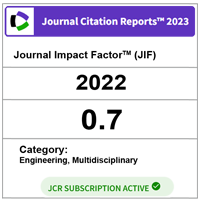TRANSFORMATION MATRICES IN GENERATION OF CIRCULAR PATTERNS
DOI:
https://doi.org/10.11113/jt.v77.6542Keywords:
Transformation matrix, patterns generation, geometryAbstract
This paper aims to explore the generation of circular patterns based on transformation matrix. The idea proposed here is to first design a fundamental pattern, known as ‘seed’. This is then followed by applying the transformation matrix to arrange the fundamental pattern to form a circular pattern. The transformation matrix can be applied once or applied iteratively. By assigning different values to the parameters involved, the patterns produced act in an interesting and appealing way.  The proposed method contributes to a simple and efficient framework in computational generation of endless circular patterns.Â
References
P. Ball. 2001. The Self-Made Tapestry: Pattern Formation in Nature. Oxford University Press.
S. Kondo, H. Shirota. 2009. Theoretical Analysis of Mechanisms That Generate the Pigmentation Pattern pf Animals. Seminars in Cell and Developmental Biology. 20(1): 82-89.
J. Briggs. 1992. Fractals: The Patterns of Chaos : A New Aesthetic of Art, Science, and Nature. Simon & Schuster.
L. Muguercia, C. Bosch1, G. Patow. 2014. Fracture Modeling in Computer Graphics. Computers & Graphics, Special Section on Aging and Weathering. 45(December): 86-100.
S. I. Sen, A. M. Day. 2005. Modelling Trees and Their Interaction with the Environment: A Survey. Computers & Graphics. 29(5, October): 805-817.
L. D. Harder, P. Prusinkiewicz. 2013. The Interplay Between Inflorescence Development and Function as the Crucible of Architectural Diversity. Annals of Botany. 112: 1477-1493.
A. C. W. Baas. 2002. Chaos, Fractals and Self-Organization in Coastal Geomorphology: Simulating Dune Landscapes in Vegetated Environments. Geomorphology. 48(13 November): 309-328.
S. V. Jablan. 2002. Symmetry, Ornament and Modularity, Series on Knots and Everything. World Scientific. 30.
A. J. Lee. 1987. Islamic Star Patterns. Muqarnas. 4: 182-197.
P. R. Cromwell. 2010. Hybrid 1-Point and 2-Point Constructions for Some Islamic Geometric Designs. Journal of Mathematics and the Arts. 4: 21-28.
C. S. Kaplan, D.H. Salesin. 2004. Islamic Star Patterns in Absolute Geometry. ACM Transactions on Graphics. 23(2): 97-119.
A. M. Aljamali, E. Banissi. 2004. Grid Method Classification of Islamic Geometric Patterns. Geometric Modeling: Techniques, Applications, Systems and Tools. 233-254.
A. K. Sen. 1999. The Product-Delay Algorithm: Graphic Design with Amplitude- and Frequency-Modulated Waveforms. Computers & Graphics. 23(1): 169-174.
A. K. Sen. 2000. Moire´ Patterns. Computers & Graphics. 24: 471-475.
G. Z. Liao, C. W. Sun. 2006. Geometric Patterns of a Recursive Waltz Dance. Digital Creativity. 17(2): 113-126.
P. Ouyang, D. Cheng, Y. Cao, X. Zhan. 2013. The Visualization of Hyperbolic Patterns from Invariant Mapping Method. Computers & Graphics. 37: 316-332.
R. J. Whitaker. 1988. Mathematics of the Spirograph. School Science and Mathematics. 88(7): 554-564.
H. M. Cundy, A. R. Rollett. 1981. Mathematical Models. Tarquin Publications.
Downloads
Published
Issue
Section
License
Copyright of articles that appear in Jurnal Teknologi belongs exclusively to Penerbit Universiti Teknologi Malaysia (Penerbit UTM Press). This copyright covers the rights to reproduce the article, including reprints, electronic reproductions, or any other reproductions of similar nature.





